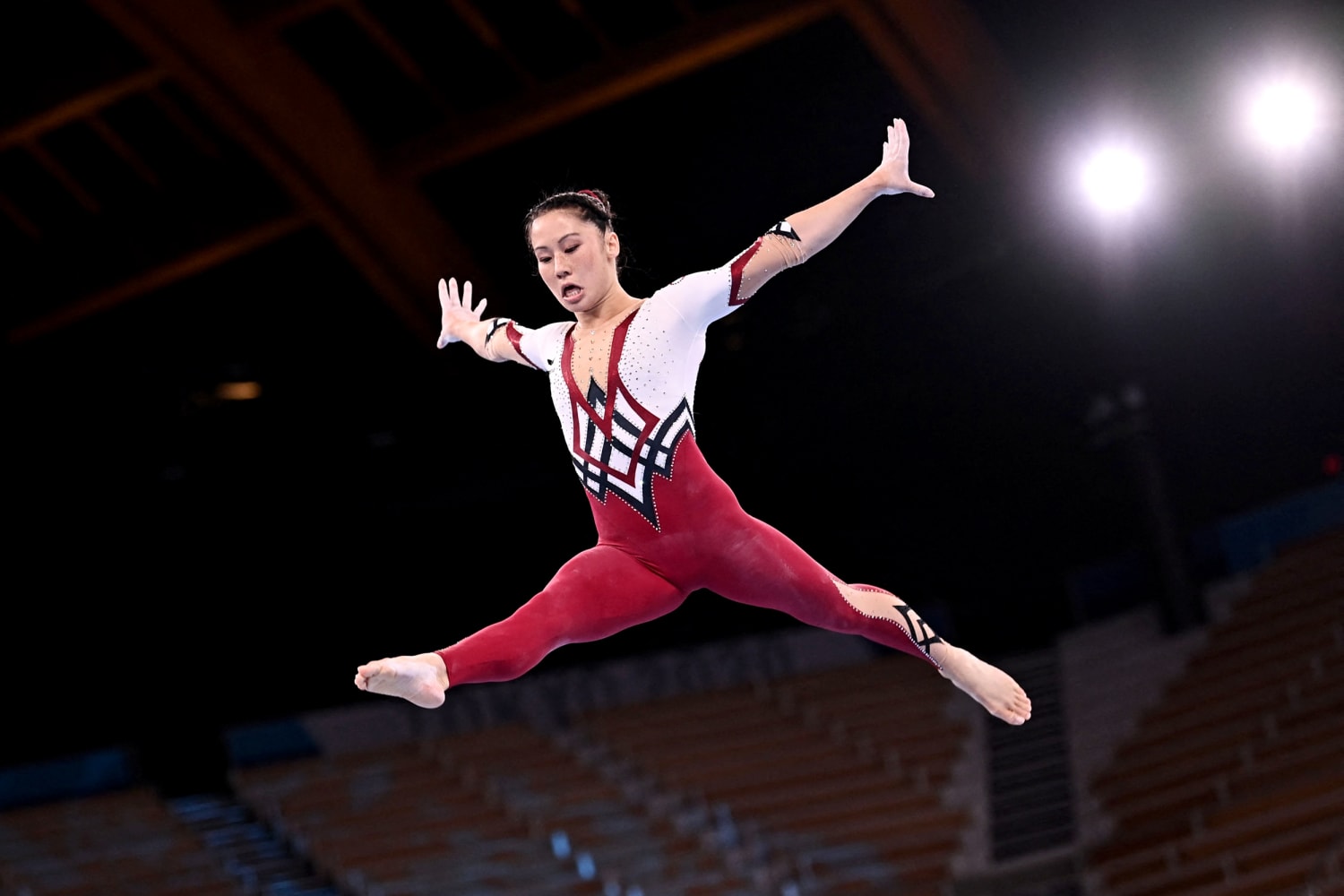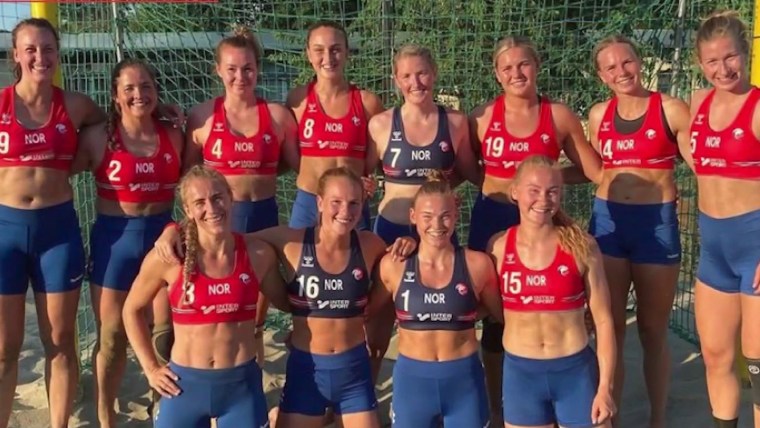TOKYO — The Tokyo Olympics could go down in history as the Games in which female athletes slammed the door on competing in skimpy outfits.
So far, German gymnasts, inspired by the Norwegian beach handball players, have led the way at these Games by scrapping their traditional — and far more revealing — uniforms in favor of more modest, and some say more comfortable, performance gear.
And, experts say, that sorority of resistance is likely to grow at an Olympics like no other which are being held despite the Covid-19 pandemic — and at which female athletes have not been shy about using the world’s biggest sports event to speak out against racism and other social issues.
“These Games are a turning point for women athletes to take control over arbitrary uniform requirements that have nothing to do with improving their participation, but are a form of controlling their bodies,” Kendra Gage, a gender and ethnic studies professor at the University of Nevada, Las Vegas, wrote in an email to NBC News.
“The Tokyo Olympics is being celebrated for having the most gender-equal games; however, these athletes are showing us that there are still significant issues surrounding gender that aren’t fixed by just increasing numbers.”
Sarah Axelson of the Women’s Sports Foundation in New York City agreed.
“It is unfortunate that far too often, attention is paid more on how female athletes look, versus their power, grit and performance,” said Axelson, who is the organization’s vice president of advocacy.
The outfits female athletes don, she said, “should help athletes feel empowered to do their best, not overshadow their efforts and bring undue scrutiny.”
There is another reason why the issue of objectifying female athletes has taken on a new urgency at the Tokyo Olympics — these are the first Summer Games since the former USA Gymnastics national team doctor, Larry Nassar, was sent to prison for life for sexually abusing hundreds of female gymnasts, including some of the sports biggest stars such as Simone Biles, Aly Raisman, McKayla Maroney and others.
And at Nassar’s sentencing, many of victims described how the sport’s culture enabled the objectification of girls and young women.
“There are a lot of people at USA Gymnastics who should never be allowed to work with children again,” Raisman later said.
But what the female athletes wear to compete in the Olympics has everything to do with the way society looks at women in general, Gage said.
“The issues that we see with women’s uniforms goes back to the very beginning of women’s participation in sports where there were larger societal fears that women would become unattractive and too masculine if they played a sport, so women’s uniforms were hyperfeminine to compensate,” she said.
Just before the 2012 London Olympics, for example, the Amateur International Boxing Association sparked international outrage by insisting that female boxers wear skirts instead of shorts, said David Wallechinsky, one of the founding members of the International Society of Olympic Historians.
The International Olympic Committee does not establish or enforce uniform regulations. That’s up to international federations for each individual sport and many of them are still run by men, Helen Jefferson Lenskyj, a professor at the University of Toronto and an expert on the Olympic Games, told France 24.
“Sports judged on aesthetics like figure skating have clothing rules consistent with judges’ often stereotypical views of what a ‘feminine’ skater should look like,” she said. “Women’s beach volleyball uniform regulations are based solely on heterosexual sex appeal.”
Case in point: the Norwegian beach handball team.
It was this group of plucky female athletes who struck the first blow against bikini bottoms earlier this month when they showed up at their sport’s Euro 2021 tournament in Bulgaria in thigh-length elastic shorts.
While the uniform for male beach handball competitors is shorts and tops, women are required to wear midriff-baring tops and bikini bottoms “with a close fit and cut on an upward angle toward the top of the leg” and a maximum side width of 4 inches, according to International Handball Federation regulations.
“It’s not [appropriate clothing for] the activity when they are playing in the sand,” Norwegian Handball Federation President Kåre Geir Lio said.
The team was fined 1,500 Euros (about $1,700) for “improper clothing” and Pink, the singer, offered to pay the penalty.
“The European handball federation SHOULD BE FINED FOR SEXISM,” Pink tweeted. “Good on ya, ladies.”
Then, at the Games, four members of the German women’s gymnastics team, Sarah Voss, Pauline Schaefer-Betz, Elisabeth Seitz and Kim Bui, showed up for the qualifying round in full-length unitards instead of the bikini-cut leotards usually worn by female gymnasts.
When they unveiled the outfits earlier in April at the European Artistic Gymnastics Championships in Switzerland, the German Gymnastics Federation declared the unitards sent a message “against sexualization in gymnastics.”
Voss said they were also striking a blow for comfort.
“To do splits and jumps, sometimes the leotards are not covering everything, sometimes they slip and that’s why we invented a new form of leotard so that everyone feels safe around competition and training,” she told the BBC.
“Some girls quit this beautiful sport (because of having to wear leotards), so that is why this is a great option for everyone to stay in the sport they love and don’t think about anything else about their body — just about their performance.”
The German women did not qualify for the finals, but in the eyes of their competitors they deserved a gold medal for gumption.
“I think it’s really cool that they have the guts to stand on such a huge arena and show girls from all over the world that you can wear whatever you want,” Norwegian gymnast Julie Erichsen said. “I applaud them for that.”
Not every gymnast opposes the bikini-cut style outfits.
Biles, who shocked the Olympic world this week by opting not to defend her all-around gold medal after pulling out of the team gymnastics final, said she prefers them because they lengthen the leg and make her appear taller. She’s 4 feet, 8 inches tall.
“But I stand with their decision to wear whatever they please and whatever makes them feel comfortable,” she told The Associated Press. “So if anyone out there wants to wear a unitard or leotard, it’s totally up to you.”
And that’s the point, the experts said.
“Selection of appropriate sport apparel is influence by many factors including performance considerations, medical and safety concerns, differences in body type,” Axelson said.
There are also cultural differences that come into play, with athletes from culturally conservative countries balk at competing in revealing outfits.
“We believe athletes should be afforded maximum flexibility in the choice of uniform fabrics and styles,” Axelson said.
Source: | This article originally belongs to Nbcnews.com











